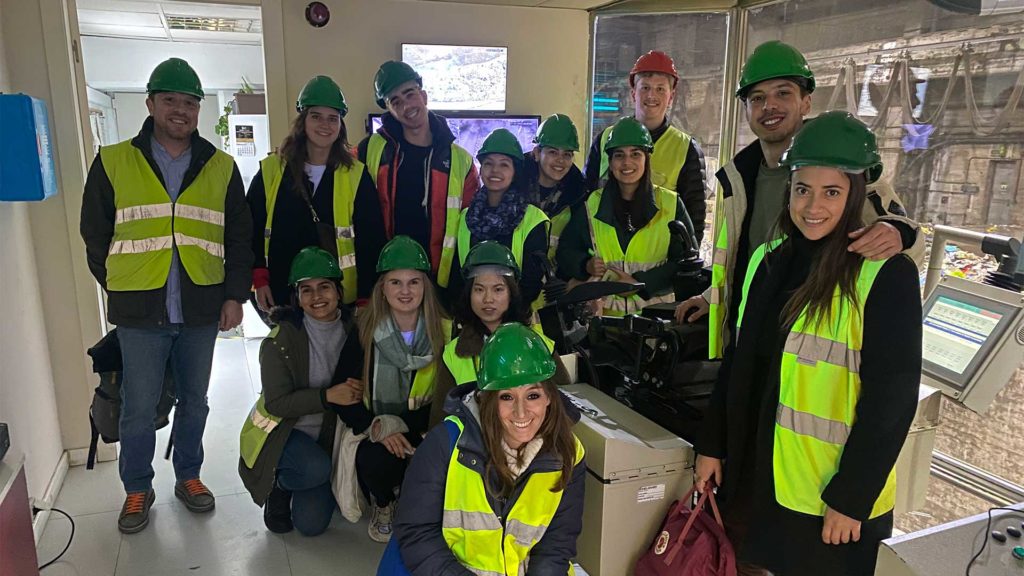ECOtwins Second Annual Meeting
26/07/2024
The UNESCO Chair in Life Cycle and Climate Change at ESCI-UPF participated in the second annual meeting of the ECOtwins project, held at the University of Copenhagen on July 18th and 19th.

On February 27th, the students of the Master of Science in Sustainability Management, jointly offered by ESCI-UPF and BSM-UPF, visited the Integrated Valorisation Plant located in Sant Adrià de Besòs to better understand the waste management treatment processes in the Metropolitan Area of Barcelona.
Based on the latest official information provided by the Catalan Institute of Statistics, in 2022, about 2.250.000 tonnes of municipal waste was generated in the Metropolitan Area of Barcelona, which means an average of 1,24kg per inhabitant per day. Of this amount, only 41% was collected separately, and the remaining 59 % was collected mixed in the grey bins.
The Metropolitan Area, through its Metropolitan Program for Prevention and Management of Municipal Resources and Waste (PREMET 25), aims to reduce the overall municipal waste and reach a recycling rate of 55% and the carbon neutrality of the global metropolitan waste treatment system by 2025.
But what happens with the waste that ends up in the grey bins?
Currently, 31% of municipal household waste from the Metropolitan Area of Barcelona ends up in the Integrated Valorisation Plant of Sant Adrià de Besòs. This plant receives the waste collected in the grey bins from Badalona, Barcelona, Sant Adrià de Besòs, Santa Coloma de Gramenet, and other municipalities of the Metropolitan Area, as well as the rejections of different sorting plants.
This integrated plant comprises two different plants: a Mechanical-Biological Treatment Plant (named ECOPARC 3), and an Energy Valorisation Plant, both managed by TERSA.
Ecoparcs are installations that manage fractions of municipal waste that are not collected separately and that contain organic matter. They manage this waste using a mechanical treatment to separate recyclable materials (such as plastics, metals, or paper) and organic content.
The recyclable materials are packed in order to be sent to recycling facilities, whereas the organic content is sent to biological treatment in the same installation. From this biological treatment, biogas is produced and recovered, and the residual waste is sent to external composting facilities to produce bio-stabilized waste that can be used for restoring roads or other applications. The rejected fraction of the mechanical treatment, as well as the biogas produced during the biological process, are sent to the Energy Valorisation Plant.
This plant carries out a controlled co-generation combustion process of both the rejected fraction and the biogas to produce steam and electricity. 12% of the generated electricity is used by the same facility, whereas the remaining 88% is sent to the electricity grid. The steam produced is used for the urban heating and cooling network of the Forum District and 22@ District. More than 100 buildings in the Forum and 22@ area are already connected to this network.
The energy produced every year by this installation is about twice the energy demand of the Barcelona City Council. Using this energy avoids the emission of 48,600 tonnes of CO2.
Learning from the visit
This visit raised awareness about the importance of recycling correctly and consuming responsibly. It also helped underline how much still needs to be done to achieve a real circular economy.
26/07/2024
The UNESCO Chair in Life Cycle and Climate Change at ESCI-UPF participated in the second annual meeting of the ECOtwins project, held at the University of Copenhagen on July 18th and 19th.
13/06/2024
Our researchers, Pere Fullana-i-Palmer and Ilija Sazdovski, collaborated with Harrison Tetteh, Rita Puig, and Mercè Balcells from the University of Lleida, and María Margallo and Ruben Aldaco from the University of Cantabria published a scientific research paper emphasizing the importance of extension of the shelf-life of products in Life Cycle Assessment.
15/05/2024
Cristina Campos, researcher of the UNESCO Chair in Life Cycle and Climate Change at ESCI-UPF, has been in Seville from 5th to 9th May as a speaker at the SETAC Europe Annual Meeting. In this article, she comments on the preliminary results of the poster and the CICEP research project, as well as her experience at the conference.
Leave a message